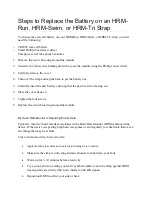
9
SDI (HD/SD) terminal (BNC)
IN1
: This is the SDI input terminal (compatible with HD/SD automatic switching).
IN2
: This is the SDI input terminal (compatible with HD/SD automatic switching).
SWITCHED OUT : This is the active through-out terminal for the SDI input signal being displayed on the screen.
* SDI active through-out is only output when [SDI1] or [SDI2] is selected using the [INPUT SELECT] buttons.
It is not output when anything other than SDI is selected. This terminal supports embedded audio.
When multiple monitors are connected in a daisy chain* pattern using the SDI active through-out, flicker or
noise may occur on the screen, depending on the quality of the original signal, length of cables or the
number of monitors connected.
* Daisy chain connection:
This is a connection method for distributing a signal to two or more devices by connecting the through-out
terminal of the first device to an input terminal of the second device, the through-output terminal of the
second device to an input terminal of the third device, and so on.
VIDEO terminal (BNC)
*1*2
IN
: This is the VIDEO signal (composite signal) input terminal.
OUT : This is the input signal through-out terminal.
DVI-D terminal
An HDCP compliant DVI-D signal input terminal.
YP
B
P
R
/RGB terminal (BNC)
*1*2
IN
: This is the YP
B
P
R
/RGB signal input terminal.
OUT : This is the input signal through-out terminal.
* When using the RGB signal, you can also connect the external synchronizing signal to the SYNC/HD
terminal. When using a PC RGB signal, connect the horizontal synchronizing signal to the SYNC/HD
terminal, and the vertical synchronizing signal to the VD terminal.
VD IN input terminal
This is the vertical synchronizing signal (VD) input terminal used when connecting to a PC RGB signal.
AUDIO input terminal (Pin terminal)
This is the common audio input terminal for all video input terminals.
* SDI input audio is automatically selected by selecting [SDI1] or [SDI2] with [INPUT SELECT].
HEAD PHONE output connector (Stereo mini-jack M3)
Connect a pair of headphones to monitor the sound.
* The sound volume and sound quality will depend on the headphones. Note that plugging in a pair of
headphones turns off the speakers.
GPI input terminal (D-SUB 9-pin)
External control is possible by using a GPI signal.
RS232C input terminal (D-SUB 9-pin)
External control is possible by using a RS232C signal.
*1 Unless a cable is connected to the OUT terminal, the VIDEO IN terminal is automatically terminated at 75
Ω
.
Connecting a cable releases this termination.
*2 Since a connection to the through-out terminal releases the 75
Ω
termination of the unit, the level of the
video signal input to the unit may become too large depending on the connected device.
Rear panel
6
8
7
9
1
2
3
4
5
Controls and Their Functions
(continued)










































